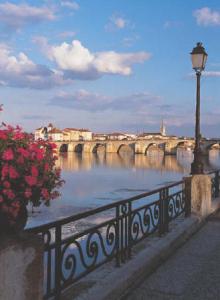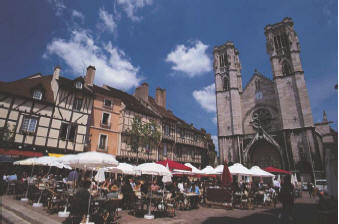The Middle Ages bequeathed to Burgundy a cluster of towns of inestimable beauty.
Be it for historical, cultural, architectural or gastronomic reasons, or for the events held annually, they are worth a visit.
Autun :
“A sister and emulator of Rome”, Augustodunum has preserved important vestiges of the Gallo-Roman period. The sculptures of the cathedral of St-Lazarus (12th C) are among the masterpieces of Romanesque art.
On display in the Rolin Museum are archaeological exhibits, statues, mediaeval exhibits and the Nativity of the Master of Moulins.
Auxerre :

Auxerre Cathedral in France
The historical town, stretched along the Yonne, has been classified in its entirety as a protected site with its numerous half-timbered houses and its picturesque clocktower.
The cathedral, a masterpiece of Gothic Art, houses a magnificent series of stained glass windows and a Romanesque crypt with the famous fresco “Christ on horseback”.
The abbey church of St Germain is built over Carolingian crypts decorated with the oldest frescoes in France (9th C).
Avallon :
This charming fortified city is dominated by its belfry. The church of St-Lazarus (11th-12th C) is famous for its magnificent doors in Burgundian Romanesque style.
Beaune :
Once the region’s main town, Beaune is now the capital of Burgundy wine. Its most beautiful building, the Hôtel-Dieu, is an old hospice built in the 15th C in Burgundian Flemish art for the seek end needy. It is famous for its multicoloured tiled roofs and the polyptych of the Last Judgement.
Other places of interest : the collegiate church and the wine museum which is housed in the former mansion of the Dukes of Burgundy.
Chalon-sur-Saône :
Stretched along the Saône, Chalon is a busy river port town and the birthplace of Photography.
The most interesting museum in the city is “Musée Nicéphore Niepce”, named after the man who invented photography in 1816. It shows an extensive collection of instruments of photography of the 19th century.
The Gothic cathedral (pictured on the left), in the heart of the city, and the chapel and the pharmacy of the former hospital are also worth a visit.
Cluny :
The Benedictine abbey cast its influence over the whole of Europe. The abbey church is a masterpiece of Romanesque art and was the largest in Western Christianity.
Cluny was a spiritual, political and artistic capital in the Middle Ages and today is the guardian of an exceptional inheritance : the ruins of the abbey church, the abbots’ palaces, the defensive towers, the cloister, the four cellars, parish churches and innumerable Romanesque houses.
The museum, dedicated to Romanesque art, is one of the richest in France.
Dijon :
The ancient and modern capital of Burgundy is one of the most beautiful and exciting provincial cities in France. Here you can visit the Dukes’ palace and illustrious noble houses; be struck by the richness of one of France’s very best fine arts museums, stroll in the spacious streets where the pedestrian reigns over the motor car, explore ancient alleys squeezed between well-restored old houses with half-timbered fronts and buy what was first grown in the vineyards, mustard.
Joigny :
Is a city of great character stretched out on the banks of the Yonne. It has preserved its mediaeval atmosphere and the historical city houses numerous churches and half-timbered houses.

Macon with the characteristic red roof tiles
Mâcon :
Pleasantly stretched on the right bank of the river Saône, Mâcon is a busy city where brick-red ‘Roman’ tiles already announce the Midi and Latin south.
Mâcon is famous for its talented son, the poet Lamartine. The Lamartine Museum is located in an aristocratic building of the 18th century (Hôtel Sénécé).
It is a very good starting point to the surrounding wine region and to the numerous Romanesque churches of Southern Burgundy.
Nevers :

Nevers porcelain, pottery and ceramics started in 16th century.
Is a lovely town on the banks of the Loire. The city is famous for its ceramics, introduced and fostered by the Gonzaga Family. The Museum of Nevers has an extensive collection of Nevers pottery and glass.
Nevers is also an important place of pilgrimage (St Bernadette) and the old town has a number of interesting mediaeval and Renaissance buildings: the cathedral of Saint Cyr and Saint Julitte, the Romanesque church of St-Stephen, remnants of the ancient fortifications (Porte du Croux, 14th C), and the Ducal Palace (late 15th C).
Paray-le-Monial :
Located in the southern part of Burgundy, Paray-le-Monial is a busy pilgrimage centre. Its basilica, built on the plan of Cluny at the end of the 11th century and in the 12th century, is a masterpiece of Romanesque architecture.
The old town has a number of half-timbered houses and interesting Renaissance buildings. The atmosphere in the pedestrian streets is more meridional than anywhere else in Burgundy.
Sens :

Sens, France, Saint-Stephen-Cathedral
Was the impressive capital of a Gallo-Roman province and the seat of an Archbishop to whom the Bishop of Paris was subordinated.
The cathedral of St-Stephen (12th-16th C) was the first in time of the great Gothic cathedrals and has stained glass windows and an ecclesiastical treasure that are among the richest in Europe. The Synod Palace is now a museum housing major Gallo-Roman and other collections.
Tournus :
The charming town centre of Tournus, on the banks of the Saône, is redolent of the Mediterranean regions. The abbey church of St-Philibert (10th-12th C) is one of the most grandiose Romanesque sanctuaries in Burgundy in which light plays on the pink stone.
Vézelay :
One of the shrines of Christianity and Western art. During the Middle Ages, Vézelay was a major pilgrimage site and a special halt on the way to Compostella.
The mediaeval town with its fortifications is dominated by the Basilica of Saint Madeleine (12th-13th C) universally considered to be a masterpiece of Romanesque art for the beauty of its architecture and the exceptional quality of its sculptured decorations. It has been classified as a World Heritage Site by UNESCO.
credits : Burgundy Tourist Board

Leave a Reply